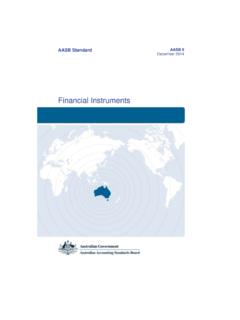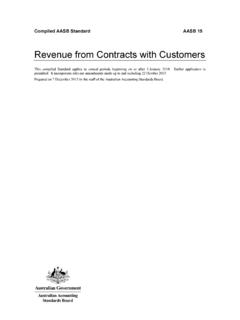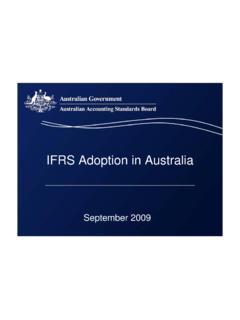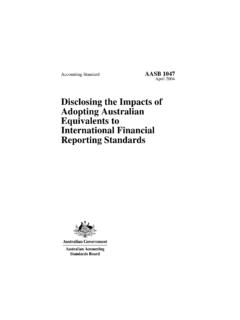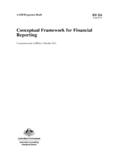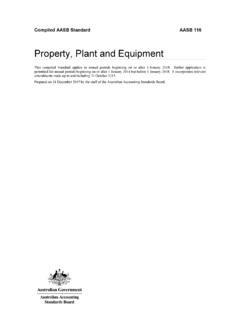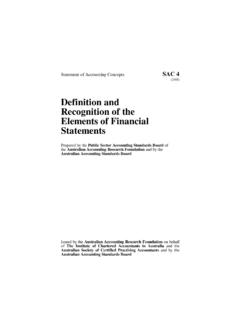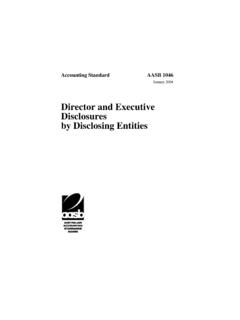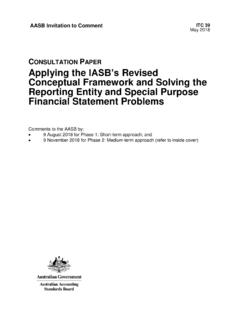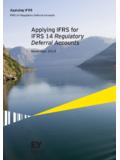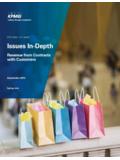Transcription of Revenue from Contracts with Customers
1 AASB Standard AASB 15. December 2014. Revenue from Contracts with Customers Obtaining a Copy of this Accounting Standard This Standard is available on the AASB website: Alternatively, printed copies of this Standard are available for purchase by contacting: The customer Service Officer Australian Accounting Standards Board Postal address: Level 7 PO Box 204. 600 Bourke Street Collins Street West Melbourne Victoria Victoria 8007. AUSTRALIA AUSTRALIA. Phone: (03) 9617 7637. Fax: (03) 9617 7608. E-mail: Website: Other Enquiries Phone: (03) 9617 7600. Fax: (03) 9617 7608. E-mail: COPYRIGHT. Commonwealth of Australia 2014. This AASB Standard contains IFRS Foundation copyright material. Reproduction within Australia in unaltered form (retaining this notice) is permitted for personal and non-commercial use subject to the inclusion of an acknowledgment of the source.
2 Requests and enquiries concerning reproduction and rights for commercial purposes within Australia should be addressed to The Director of Finance and Administration, Australian Accounting Standards Board, PO Box 204, Collins Street West, Victoria 8007. All existing rights in this material are reserved outside Australia. Reproduction outside Australia in unaltered form (retaining this notice) is permitted for personal and non-commercial use only. Further information and requests for authorisation to reproduce for commercial purposes outside Australia should be addressed to the IFRS Foundation at ISSN 1036-4803. AASB 15 2 COPYRIGHT. CONTENTS. PREFACE. COMPARISON with IFRS 15. INTRODUCTION TO IFRS 15. (available on the AASB website). ACCOUNTING STANDARD. AASB 15 Revenue FROM Contracts with Customers . Paragraphs Objective 1. Meeting the objective 2 4.
3 Application Reduced disclosure requirements Commencement Scope 5 8. Recognition Identifying the contract 9 16. Combination of Contracts 17. contract modifications 18 21. Identifying performance obligations 22 23. Promises in Contracts with Customers 24 25. Distinct goods or services 26 30. Satisfaction of performance obligations 31 34. Performance obligations satisfied over time 35 37. Performance obligations satisfied at a point in time 38. Measuring progress towards complete satisfaction of a performance obligation 39 45. Measurement 46. Determining the transaction price 47 49. Variable consideration 50 59. The existence of a significant financing component in the contract 60 65. Non-cash consideration 66 69. Consideration payable to a customer 70 72. Allocating the transaction price to performance obligations 73 75. AASB 15 3 CONTENTS.
4 Allocation based on stand-alone selling prices 76 80. Allocation of a discount 81 83. Allocation of variable consideration 84 86. Changes in the transaction price 87 90. contract costs Incremental costs of obtaining a contract 91 94. Costs to fulfil a contract 95 98. Amortisation and impairment 99 104. Presentation 105 109. Disclosure 110 112. Contracts with Customers 113. Disaggregation of Revenue 114 115. contract balances 116 118. Performance obligations 119. Transaction price allocated to the remaining performance obligations 120 122. Significant judgements in the application of this Standard 123. Determining the timing of satisfaction of performance obligations 124 125. Determining the transaction price and the amounts allocated to performance obligations 126. Assets recognised from the costs to obtain or fulfil a contract with a customer 127 128.
5 Practical expedients 129. Appendices: A. Defined Terms Page 47. B. Application Guidance Page 49. C. Effective Date and Transition Page 73. DELETED IFRS 15 TEXT Page 76. ILLUSTRATIVE EXAMPLES. (available on the AASB website). BASIS FOR CONCLUSIONS ON IFRS 15. (available on the AASB website). AASB 15 4 CONTENTS. Australian Accounting Standard AASB 15 Revenue from Contracts with Customers is set out in paragraphs 1 129 and Appendices A C. All the paragraphs have equal authority. Paragraphs in bold type state the main principles. Terms defined in Appendix A are in italics the first time they appear in the Standard. AASB 15 is to be read in the context of other Australian Accounting Standards, including AASB 1048 Interpretation of Standards, which identifies the Australian Accounting Interpretations. In the absence of explicit guidance, AASB 108 Accounting Policies, Changes in Accounting Estimates and Errors provides a basis for selecting and applying accounting policies.
6 AASB 15 5 CONTENTS. PREFACE. Introduction The Australian Accounting Standards Board (AASB) makes Australian Accounting Standards, including Interpretations, to be applied by: (a) entities required by the Corporations Act 2001 to prepare financial reports;. (b) governments in preparing financial statements for the whole of government and the General Government Sector (GGS); and (c) entities in the private or public for-profit or not-for-profit sectors that are reporting entities or that prepare general purpose financial statements. AASB 1053 Application of Tiers of Australian Accounting Standards establishes a differential reporting framework consisting of two tiers of reporting requirements for preparing general purpose financial statements: (a) Tier 1: Australian Accounting Standards; and (b) Tier 2: Australian Accounting Standards Reduced Disclosure Requirements.
7 Tier 1 requirements incorporate International Financial Reporting Standards (IFRSs), including Interpretations, issued by the International Accounting Standards Board (IASB), with the addition of paragraphs on the applicability of each Standard in the Australian environment. Publicly accountable for-profit private sector entities are required to adopt Tier 1 requirements, and therefore are required to comply with IFRSs. Furthermore, other for-profit private sector entities complying with Tier 1. requirements will simultaneously comply with IFRSs. Some other entities complying with Tier 1 requirements will also simultaneously comply with IFRSs. Tier 2 requirements comprise the recognition and measurement requirements of Tier 1 but substantially reduced disclosure requirements in comparison with Tier 1. Australian Accounting Standards also include requirements that are specific to Australian entities.
8 These requirements may be located in Australian Accounting Standards that incorporate IFRSs or in other Australian Accounting Standards. In most instances, these requirements are either AASB 15 6 PREFACE. restricted to the not-for-profit or public sectors or include additional disclosures that address domestic, regulatory or other issues. These requirements do not prevent publicly accountable for-profit private sector entities from complying with IFRSs. In developing requirements for public sector entities, the AASB considers the requirements of International Public Sector Accounting Standards (IPSASs), as issued by the International Public Sector Accounting Standards Board (IPSASB) of the International Federation of Accountants. Reduced disclosure requirements The disclosure requirements for entities preparing general purpose financial statements under Australian Accounting Standards Reduced Disclosure Requirements are identified in paragraph AASB 15 7 PREFACE.
9 COMPARISON with IFRS 15. AASB 15 Revenue from Contracts with Customers incorporates IFRS 15. Revenue from Contracts with Customers issued by the International Accounting Standards Board (IASB). Paragraphs that have been added to this Standard (and do not appear in the text of IFRS 15) are identified with the prefix Aus , followed by the number of the preceding IASB paragraph and decimal numbering. Entities that comply with AASB 15 will simultaneously be in compliance with IFRS 15. AASB 15 8 COMPARISON. ACCOUNTING STANDARD AASB 15. The Australian Accounting Standards Board makes Accounting Standard AASB 15 Revenue from Contracts with Customers under section 334 of the Corporations Act 2001. Kris Peach Dated 12 December 2014 Chair AASB. ACCOUNTING STANDARD AASB 15. Revenue FROM Contracts with . Customers . Objective 1 The objective of this Standard is to establish the principles that an entity shall apply to report useful information to users of financial statements about the nature, amount, timing and uncertainty of Revenue and cash flows arising from a contract with a customer .
10 Meeting the objective 2 To meet the objective in paragraph 1, the core principle of this Standard is that an entity shall recognise Revenue to depict the transfer of promised goods or services to Customers in an amount that reflects the consideration to which the entity expects to be entitled in exchange for those goods or services. 3 An entity shall consider the terms of the contract and all relevant facts and circumstances when applying this Standard. An entity shall apply this Standard, including the use of any practical expedients, consistently to Contracts with similar characteristics and in similar circumstances. 4 This Standard specifies the accounting for an individual contract with a customer . However, as a practical expedient, an entity may apply this Standard to a portfolio of Contracts (or performance obligations) with similar characteristics if the entity reasonably expects that the effects on the financial statements of applying this Standard to the portfolio would not differ materially from applying this Standard to the individual Contracts (or performance obligations) within that portfolio.
